Bagri language
| Bagri | |
|---|---|
| बागड़ी | |
| Native to | Rajasthan, Haryana and Punjab (including Bahawalpur and Bahawalnagar district in Pakistan) |
| Ethnicity | Bagri |
Native speakers |
1,890,815 (2011 census)[1] Census results conflate some speakers with Hindi.[2] |
|
Indo-European
| |
| Devanagari | |
| Official status | |
Recognised minority language in | |
| Language codes | |
| ISO 639-3 |
bgq |
| Glottolog |
bagr1243[3] |
The Bagri language (बागड़ी) forms something of a dialect bridge between Rajasthani, Punjabi and Haryanvi Hindi and takes its name from the Bagar tract region of Northwestern India.[4] It has about two million speakers, mostly in India, with pockets in the Bahawalpur and Bahawalnagar districts of the Punjab in Pakistan.
Bagri is a typical Indo-Aryan language, with SOV word order. The most striking phonological feature of Bagri is the presence of three lexical tones: high, mid and low, akin to Punjabi.[5] The language has a very high (65%) lexical similarity with Haryanvi.
Features
Phonology
Bagri distinguishes 31 consonants including a retroflex series, 10 vowels, 2 diphthongs and 3 tones.
Declension
- There are two numbers: singular and plural.
- Two genders: masculine and feminine.
- Three cases: simple, oblique, and vocative. Case marking is partly inflectional and partly postpositional.
- Nouns are declined according to their final segments.
- All pronouns are inflected for number and case but gender is distinguished only in the third person singular pronouns.
- The third person pronouns are distinguished on the proximity/remoteness dimension in each gender.
- Adjectives are of two types: either ending in /-o/ or not.
- Cardinal numbers up to ten are inflected.
- Both present and past participles function as adjectives.
Verbs
- There are three tenses and four moods.
Syntax
- Sentence types are of traditional nature.
- Coordination and subordination are very important in complex sentences.
- Parallel lexicon are existing and are very important from sociolinguistic point of view.
Samples
| Bagri | Transliteration | Translation |
|---|---|---|
| तेरो नाम के है | Tero nāma ke hai | What is your name? |
| किन्नै जावै है? | kinn jāv hai | Where are you going? |
| इन्नै आ | innai ā | Come here |
| क्यूकर है ? | kyūkara hai | How are you? |
| टींगर टीटणं नां मार | ṭīṅgara ṭīṭaṇaṃ nāṃ māra | Hey kid! Don't waste our time. |
| तन्नै कुचरणीं ही करनी है के ? | tannai kučaraṇīṃ hī leṇīṃ hai ke | Do you only want to disturb things? |
| नास में आन्गळी ना ले | nāma meṃ āngaḷī nā le | Don't penetrate finger into nose. |
| बातां गा पीसा लागै है. | bātāṃ gā pīsā lāgai | Talking costs money. |
| मुह कर जिया बताऊ जिसों या मुंह कर बताऊ बरगो | suha kara jiyā batāū jisoṃ | Your face looks like eggplant. |
| मान ग्या र, सागी है बटो | Maan gya r, saagi h bto | Shame on You, same as Asshole. |
| क्यांमी राफ चोड़ी करै है रे? | kyāmī rāpha čoṛī karai hai re | Why are you making your mouth as that of a moron? |
| के करे है? | ke kare ha | What are you doing? |
| रोल्लो है के कोई तेरै | rollo ha ke koī terai | you have any problem |
| तू कठै गयैड़ो हो | too kathai gayairo ho | Where did you go? |
| कठैउं आन लाग रह्यो है? | kaṭhū ān lāga rahyo ha | Where are you coming from? |
| भांडा | bhanda | Utensils. |
| घोड़ो होव जिओं | Ghodo hov jiya | Looking like a horse |
| कोजवाड़ | kozwaD | embarrassing. |
Work on Bagri
- Grierson, G. A. 1908. (Reprint 1968). Linguistic Survey of India. Volume IX, Part II. New Delhi: Motilal Banarasidass
- Gusain, Lakhan. 1994. Reflexives in Bagri. M.Phil. dissertation. New Delhi: Jawaharlal Nehru University
- Gusain, Lakhan. 1999. A Descriptive Grammar of Bagri. Ph.D. dissertation. New Delhi: Jawaharlal Nehru University
- Gusain, Lakhan. 2000a. Limitations of Literacy in Bagri. Nicholas Ostler & Blair Rudes (eds.). Endangered Languages and Literacy. Proceedings of the Fourth FEL Conference. University of North Carolina, Charlotte, 21–24 September 2000
- Gusain, Lakhan. 2000b. Bagri Grammar. Munich: Lincom Europa (Languages of the World/Materials, 384)
- Gusain, Lakhan. 2008. Bagri Learners' Reference Grammar. Ann Arbor, Michigan: Northside Publishers
- Wilson, J. 1883. Sirsa Settlement Report. Chandigarh: Government Press
Gallery
Regions where Bagri is spoken:
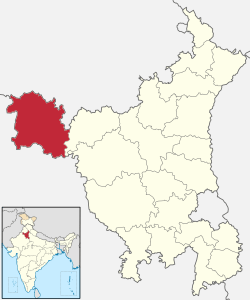 Bagri is the main language in Sirsa district.
Bagri is the main language in Sirsa district.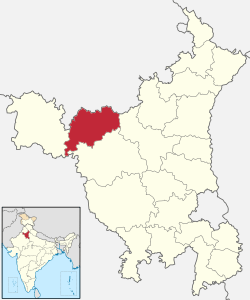 Bagri is the main language in western Fatehabad district.
Bagri is the main language in western Fatehabad district.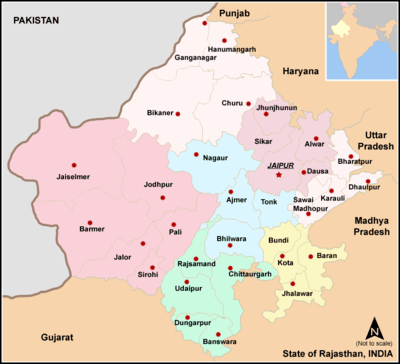 Bagari is the main language of Ganganagar district, Hanumangarh district, north-western part of churu district and north-western part of Jhunjhunu district in Rajasthan.
Bagari is the main language of Ganganagar district, Hanumangarh district, north-western part of churu district and north-western part of Jhunjhunu district in Rajasthan.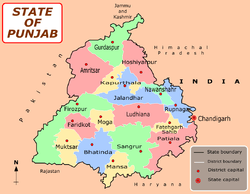 Bagari is the main language in Fazilka district (now a separate district, formerly southern part of Firozpur district) and as minority language in southern villages of Muktsar district of Punjab (India).
Bagari is the main language in Fazilka district (now a separate district, formerly southern part of Firozpur district) and as minority language in southern villages of Muktsar district of Punjab (India).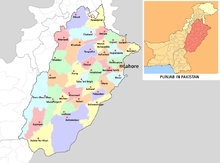 Bagri is a minor language is spoken in Bahawalpur and Bahawalnagar district of Punjab, Pakistan, though not considered parts of Bagar tract.
Bagri is a minor language is spoken in Bahawalpur and Bahawalnagar district of Punjab, Pakistan, though not considered parts of Bagar tract.
See also
References
- ↑ "Statement 1: Abstract of speakers' strength of languages and mother tongues - 2011". www.censusindia.gov.in. Office of the Registrar General & Census Commissioner, India. Retrieved 2018-07-07.
- ↑ Census India 2001
- ↑ Hammarström, Harald; Forkel, Robert; Haspelmath, Martin, eds. (2017). "Bagri". Glottolog 3.0. Jena, Germany: Max Planck Institute for the Science of Human History.
- ↑ Revised Land and Revenue Settlement of Hisar District 9006-9011
- ↑ Gusain 2000, p. 14.
Bibliography
- Gusain, Lakhan (2000). Bagri. Languages of the world. Materials. Munich: LINCOM Europa. ISBN 978-3-89586-398-1.
External links
This article is issued from
Wikipedia.
The text is licensed under Creative Commons - Attribution - Sharealike.
Additional terms may apply for the media files.